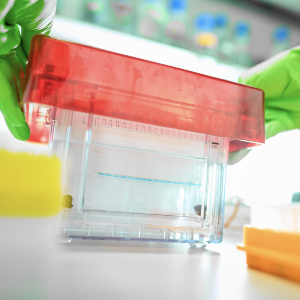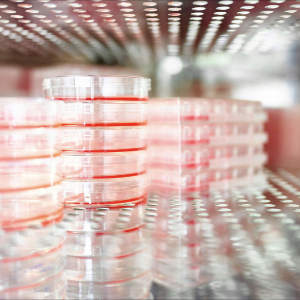Underestimated alarm signal: RNA damage moves into the spotlight
20 Feb 2025
RNA is relatively short-lived, which is why RNA damage was long considered less relevant. Biochemist Julian Stingele explains in an interview why this view has changed.
20 Feb 2025
RNA is relatively short-lived, which is why RNA damage was long considered less relevant. Biochemist Julian Stingele explains in an interview why this view has changed.

erforscht Schäden an den Nukleinsäuren DNA und RNA. | © LMU / Jan Greun
Julian Stingele, Professor at the LMU Munich Gene Center, is researching the cellular mechanisms for recognizing and degrading DNA and RNA damage. Using an interdisciplinary approach, he wants to fundamentally understand how cells ensure their functionality by identifying and degrading damaged nucleic acids. Together with his colleagues Jacqueline Cordes and Shubo Zhao, Stingele has written a review article on the subject of RNA damage, which has been published in the renowned journal Cell. In this interview, Julian Stingele talks about current findings, challenges and future prospects for RNA research.
There is already a relatively large amount of research on DNA repair, but RNA has so far received less attention. Why is that?
Julian Stingele: It has long been assumed that RNA damage is not so relevant because there is a big difference between RNA and DNA: DNA is passed on, so any damage to DNA can lead to long-term changes in genetic information. RNA molecules, on the other hand, are broken down and synthesized again and again. They therefore have a relatively short life and it has been assumed that damage is probably not particularly relevant because damaged RNA can simply be disposed of.
Why has this changed?
RNA is one of the most important molecules in our cells. Almost every biological function of our cells is mediated by RNA. It is therefore incredibly important that cells ensure the integrity of their RNA molecules. In the last two to three years in particular, research groups have found evidence that cells react very specifically to damaged RNA. For example, it has been found that acute cell death after UV irradiation is almost entirely mediated by the RNA damage caused.
Just over a year ago, we discovered a new cellular mechanism that recognizes and degrades damaged RNAs. This leads to the logical conclusion that there must be a selection pressure that ensures that such mechanisms develop in the course of evolution. This means that there is clearly a need for these mechanisms. That is why we want to take a closer look at RNA damage in the future and investigate how cells recognize and resolve it. We think that we are working on really fundamental biological questions here. To support this research, we received a Consolidator Grant from the European Science Council last year in the amount of
We believe that we are working on truly fundamental biological questions here.JULIAN STINGELE

© LMU / Jan Greune
How do RNA damages occur?
On one hand, there are RNA damages caused by environmental factors. For instance, UV radiation, but also X-rays or radioactive radiation can damage RNA molecules.
In addition to these external influences, our metabolism continuously produces reactive substances that can damage RNA. This is completely normal, and these reactive molecules are usually not very long-lived, but there is always the chance that one of them could damage RNA. This means that RNA damage is unavoidable, even if one never goes out in the sun.
In your review article, you mention two key roles in the recognition of RNA damage. What are they?
We believe that one key role of the RNA damage response is to ensure the immediate survival of the cell. It is less about restoring the function of the damaged RNA. We suspect that recognizing and resolving the damage is more important. This works remarkably well. When we induce RNA damage in cells, we observe that the cells respond very efficiently within minutes.
Another aspect is: If a cell experiences RNA damage, it is likely also simultaneously suffering from DNA damage. We hypothesize that the recognition of RNA damage serves as an alarm signal for the cell, indicating that there is probably also a problem with the DNA. The cell can then trigger its own death, thereby preventing the possibility of transforming into a tumor cell in the medium term.
As a concept, it is becoming increasingly clear that cells do not directly recognize the damage itself but rather sense the effect of the damage. The mechanism we have discovered is triggered, for example, when the damage blocks the translation of mRNA in the ribosome. The ribosomes get stuck and essentially collide with one another. The exact identity of the damage is not all that relevant. Therefore, this is a very efficient mechanism to recognize various types of RNA damage.
RNA damage is unavoidable, even if one never goes out in the sun.JULIAN STINGELE
What are the biggest challenges in RNA damage research?
A major challenge is that most sources of RNA damage also cause DNA damage. This means that when we study cells, it is relatively difficult to distinguish whether the effect is due to the RNA damage or the DNA damage that occurred simultaneously.
To address this problem, we are trying to develop systems where we can specifically damage RNA without causing concurrent DNA damage. One trick we use is to "feed" the cells a modified building block. This building block is incorporated only into RNA, not DNA, and can then be specifically damaged by low-energy radiation after being incorporated into the RNA. In this way, we can induce RNA damage specifically and analyze the effects attributed to this damage.
Is there evidence that RNA damage is linked to diseases?
We are still relatively early in this area, but there are several indications. For example, a fat- and sugar-rich diet often leads to the formation of so-called reactive oxygen species. In a mouse model, it has been shown that the inflammation associated with such a diet seems to be largely caused by RNA damage.
More direct evidence comes from chemotherapy. This is an area where our research group is focusing as well. The accepted mechanism for many chemotherapy drugs is that they damage the DNA in tumor cells, ultimately leading to the death of these cells.
However, many of these chemotherapy drugs also damage RNA. To date, little has been investigated regarding the extent to which RNA damage contributes to the success of the therapy or its side effects. We are studying the chemotherapy drug Azacitidine, which is primarily used in the treatment of a specific type of leukemia. And at least in cell cultures, we see that the acute toxicity of this chemotherapy drug is almost entirely mediated by RNA damage.
Could this also be medically relevant?
It was incredibly interesting for us that a chemotherapy drug that has been used for years likely works quite differently than originally thought. The drug doesn't work for all patients, and we don't yet know why. It would be very important to understand exactly how it works in order to predict which patients will respond well to it and which won't.
In a genetic screen, we tested all 20,000 human genes and identified one gene that has by far the largest effect on the RNA damage response to this chemotherapy drug. When this gene is removed, the cells lose their ability to respond to RNA damage. They then become very sensitive to the chemotherapy. In contrast, removing various DNA repair genes does not show this effect. The drastic nature of this result was something we hadn't even dreamed of.
One hope, of course, is that we can eventually pharmacologically modulate this RNA damage response to make tumor cells more sensitive to RNA damage, thereby improving therapies.
It was incredibly interesting for us that a chemotherapy drug that has been used for years likely works quite differently than originally thought.JULIAN STINGELE

© LMU / Jan Greune
Where do you see the greatest research needs in the future?
One aspect is to increasingly investigate disease-relevant questions – for example, to what extent RNA damage is caused by chemotherapy and how it influences the success of the therapy.
Another blind spot we want to address is the effects on different types of RNA. Currently, almost all research focuses on damage to mRNAs, the carriers of the blueprints for proteins. However, these make up only a small part of the RNA in our cells. The majority of cellular RNAs perform other functions. We know little to nothing about how damage to these RNA molecules is recognized and what consequences it has. This is also a major focus of our work.
The environment at LMU Munich provides ideal conditions for this: We can collaborate with leading experts in ribosome and RNA biology, and through cooperation with partners at the LMU Klinikum, we have short paths to doctors who use the chemotherapies we are researching.
What drives you personally to work in this still young research field?
Suddenly, we have a completely new perspective here. This is very stimulating and interesting, and it's incredibly rewarding to know that there is still such a large field ahead of us where we can truly contribute. There are so many questions to address, and the problem is not finding them, but rather deciding which one to work on first.